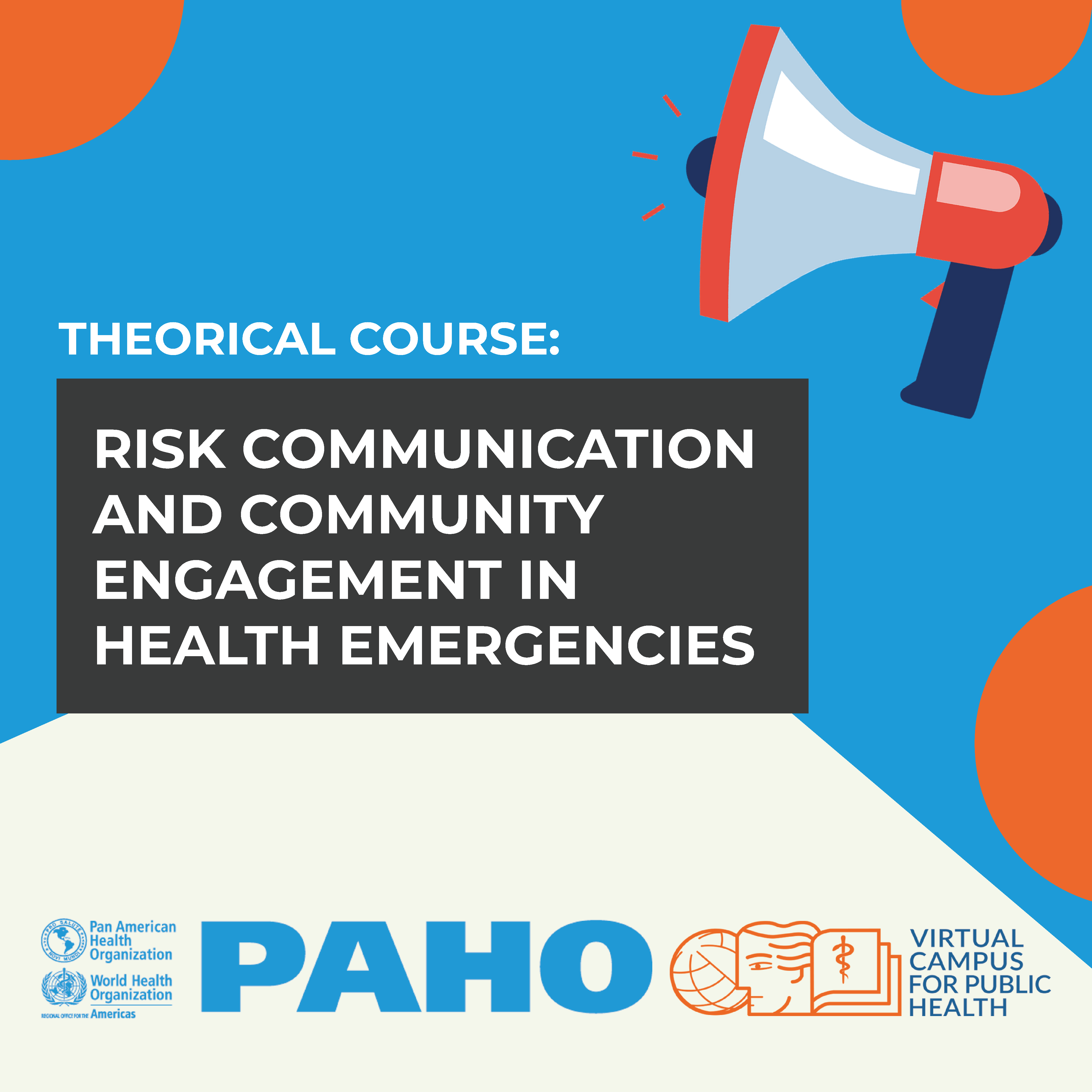
VERSIÓN ESPAÑOL ENGLISH VERSION
Introduction
The "Risk Communication and Community Engagement (RCCE)" course responds to the technical cooperation provided by PAHO/WHO to its Member States, as part of efforts to update and strengthen risk communication systems in preparedness, mitigation, and response to health emergencies. It utilizes materials developed by PAHO/WHO, UN agencies, and other internationally recognized academic organizations and authors. This course lays the groundwork for understanding the importance of risk communication in responding to health emergencies through the application of strategies that empower communities.
Purpose of the course
Expanding on the previously mentioned, the goal of the course is for participants to recognize the importance of risk communication as a capability on par with epidemiology and provision of healthcare, through the application of strategies that minimize risks and empower communities to make evidence-based decisions to preserve their health and lives.
Specifically, three (3) key objectives are pursued:
- By the end of the course, participants will understand the concept of Risk Communication, identify its basic components and guide principles for best practices in its development, especially during health emergencies.
- Participants will employ skills and tools to communicate risks in a timely manner to target audiences and key stakeholders during health emergencies.
- Participants will utilize consistent planning processes for communication response throughout the phases of emergency management, which include preparation, mitigation, and response to multiple threats.
Competencies
The course provides an opportunity for public health workers to develop competencies related to risk communication and community engagement strategies in health emergencies and to gain theoretical knowledge of technical concepts that underpin risk communication as a fundamental capacity of the International Health Regulations (2005).
Learning objectives
Throughout the course, participants are expected to achieve the following:
- Understand the basic concepts, purposes, and principles of risk communication in the context of preparedness, mitigation, and response to public health emergencies.
- Manage the challenge of transparency in risk communication during emergencies.
- Explore complex issues related to coordinating communication among different stakeholders.
- Determine appropriate risk communication strategies for addressing various scales and orientations in risk perception, interests, and concerns to strengthen community engagement.
- Develop effective risk communication strategies and plans in response to the demands of health emergencies.
Target Audience
The intended audience includes health authorities, officials designated as spokespersons, and communication professionals who may fulfill a role in the preparation and response to health emergencies.
The recommended participant profile for this course includes:
- Health authorities and decision-makers
- Communication professionals
- Technical and operational staff from central-level Ministries of Health and regional authorities
- Community leaders
- Technical and operational staff from key public, private, and social institutions/organizations involved in planning and responding to health emergencies and disasters
- Anyone interested in risk communication
Duration and Commitment
The course is open and available on the VCPH. As it is a self-paced course, participants can select modules and lessons at their own pace. It is estimated that the time required to complete the seven modules of the course and associated exercises is 7 hours.
Teaching Strategies
Self-paced, free, open to the public, and self-administered course. The course is conducted online, on the Moodle virtual education platform of the PAHO Virtual Campus for Public Health (VCPH).
The modules feature various educational materials such as audiovisual presentations, reading documents, maps, and practical activities.
Course Structure
The course consists of seven learning modules. The contents are developed as detailed below:
Section 1: Introduction to Risk Communication
Module 1: Risk Communication: Concepts and Principles
Content:
- Context of health emergencies and challenges for Risk Communication
- The International Health Regulations (IHR) and Risk Communication and Community Engagement as a core capacity
- Evolution of risk communication
- Basic concepts and principles of Risk Communication
- Risk and risk perception
Section 2: Risk Communication and Community Engagement
Module 2: Coordination with partners and allies
Content:
- The importance of coordination in health emergencies and the involvement of partners and allies
- Partner and ally mapping and principles of collaborative work
Module 3: Adapting Communication: Social Listening
Content:
- Concepts and importance of social listening
- Mechanisms of social listening, integrating perceptions into the response
- Engaging and empowering communities
Module 4: Introduction to Infodemic Management Content:
- Concepts of infodemic and its public health implications
- Infodemic management in a health emergency
- Designing people-centered interventions for infodemic management
Module 5: Public Communication during Health Emergencies
Content:
- Challenges of Risk Communication in public communication
- Tailoring science according to audiences
- Types of information to use in messages
- Principles and steps for developing effective messages
- Crafting a message map
Módulo 6: Community Engagement
Content:
- Concept of community and community engagement
- Principles and pillars of community engagement and empowerment
Module 7: Strategic Planning for Risk Communication
Content:
- Develop a Risk Communication system
- Develop a Multi-Threat Risk Communication Strategy
